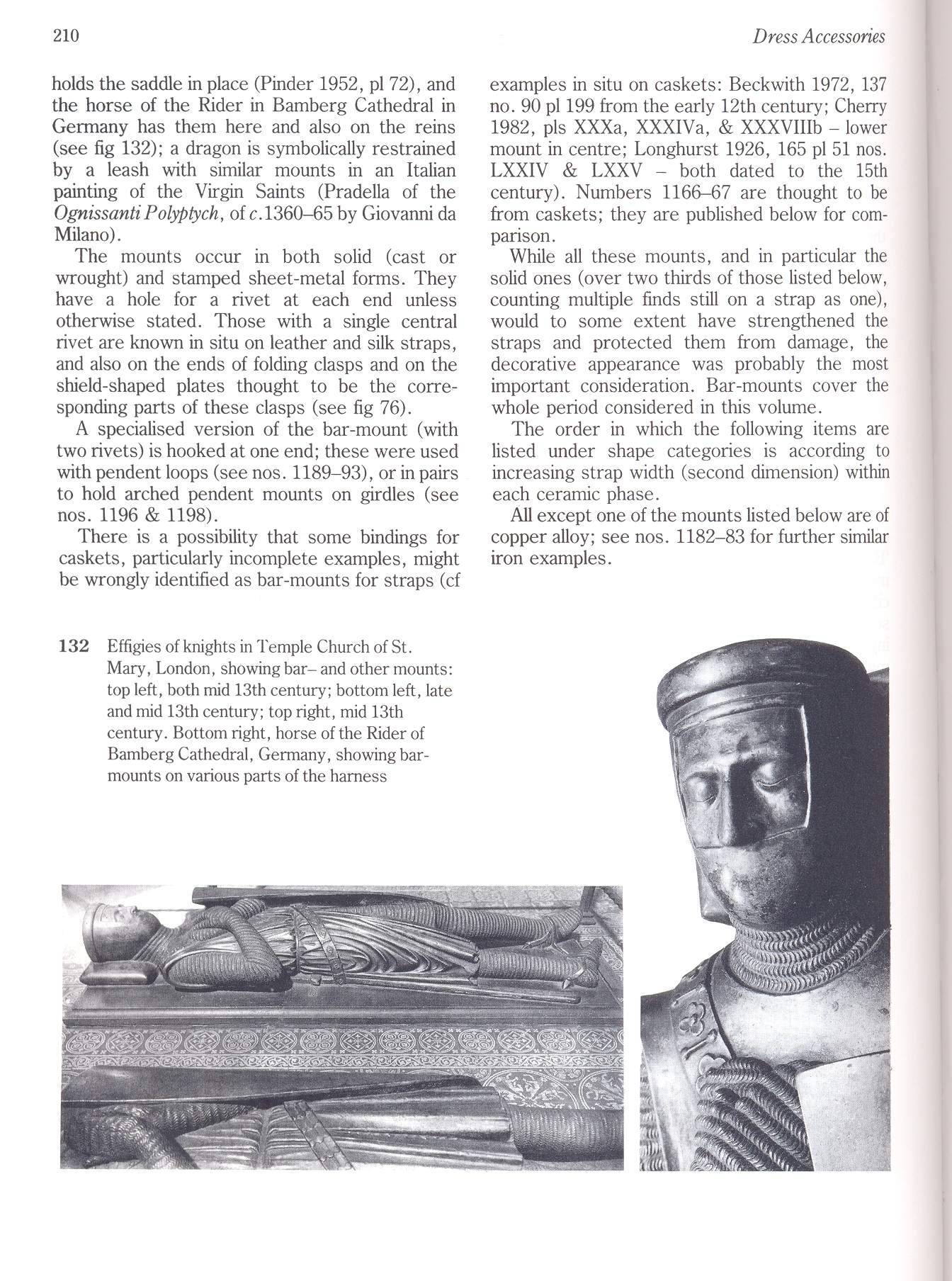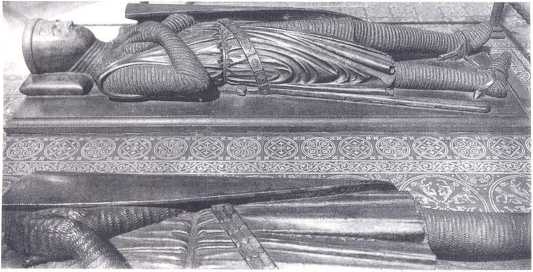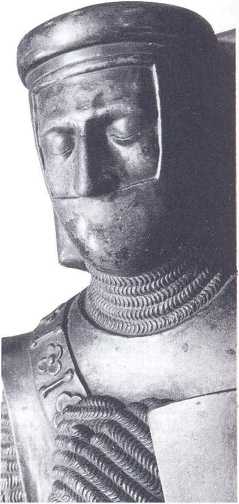239 (45)

210
Dress Accessońes
holds the saddle łn place (Pinder 1952, pl 72), and the horse of the Rider in Bamberg Cathedral in Germany has them here and also on the reins (see fig 132); a dragon is symbolically restrained by a leash with similar mounts in an Italian painting of the Virgin Saints (Pradella of the Ognissanti Polyptych, of c. 1360-65 by Giovanni da Milano).
The mounts occur in both solid (cast or wrought) and stamped sheet-metal forms. They have a hole for a rivet at each end unless otherwise stated. Those with a single central rivet are known in situ on leather and silk straps, and also on the ends of folding clasps and on the shield-shaped plates thought to be the corre-sponding parts of these clasps (see fig 76).
A specialised version of the bar-mount (with two rivets) is hooked at one end; these were used with pendent loops (see nos. 1189-93), or in pairs to hołd arched pendent mounts on girdles (see nos. 1196 & 1198).
There is a possibility that some bindings for caskets, particularly incomplete examples, might be wrongly identified as bar-mounts for straps (cf examples in situ on caskets: Beckwith 1972, 137 no. 90 pl 199 from the early 12th century; Cherry 1982, pis XXXa, XXXIVa, & XXXVIIIb - lower mount in centre; Longhurst 1926, 165 pl 51 nos. LXXIV & LXXV - both dated to the 15th century). Numbers 1166-67 are thought to be from caskets; they are published below for com-parison.
While all these mounts, and in particular the solid ones (over two thirds of those listed below, counting multiple finds still on a strap as one), would to some extent have strengthened the straps and protected them from damage, the decorative appearance was probably the most important consideration. Bar-mounts cover the whole period considered in this volume.
The order in which the following items are listed under shape categories is according to increasing strap width (second dimension) within each ceramic phase.
All except one of the mounts listed below are of copper alloy; see nos. 1182-83 for further similar iron examples.
132 Effigies of knights in Tempie Church of St.
Mary, London, showing bar- and other mounts: top left, both mid 13th century; bottom left, late and mid 13th century; top right, mid 13th century. Bottom right, horse of the Rider of Bamberg Cathedral, Germany, showing bar-mounts on various parts of the hamess


Wyszukiwarka
Podobne podstrony:
Ask Me Everything!0 Tell me morę: Arab dress Igal: Double black cord that holds the gutra in placeWh
377 (19) 350 Dress Accessońes 1700 BC72 2822 (150) 11 fig 231 Pouch madę from a rectangular strip of
bibliographie CIS dagę (The size-distribution and protease content of airborne particles in tex-tile
Tax expenditures: spending through the Polish tax system 97 Tablc 2. Size and fiscal effects of tax
57619 s&h 073 73 STKKNCTH AND HEALTH aro of materiał assistance in the rejeetion of certain flnids a
34986 img017 Introduction The Swiss Bali is a familiar and inexpensive piece of eąuipment found in m
About Tables The table is the basie unit of data storage in an Oracle database. It holds all user-ac
276 (40) 248 Dress Accessońes because no indication has been recognized on them of the wearer’s adhe
302 (41) 274 Dress Accessońes buttons of the former kind, found in Lund in Sweden). Composite sheeti
306 (35) 180 180 278 Dress Accessońes Cloth buttons and corresponding holes on a sleeve from a depos
308 (39) 280 Dress Accessońes late 13th century onwards. The alloys used in buttons prior to that co
318 (36) 290 Dress Accessories one has a tiny spoon at the opposite end from the nib, though MoL acc
322 (32) 294 Dress Accessories Unthrown silk was bound round the wire in at least 11 examples (nos.
420 (12) 393Metallurgical Analysis of the Dress Accessories Lead Lead Fig 266 Copper alloys c. 1270-
422 (13) Metallurgical Analysis of the Dress Accessories site form which include a forked spacer san
więcej podobnych podstron